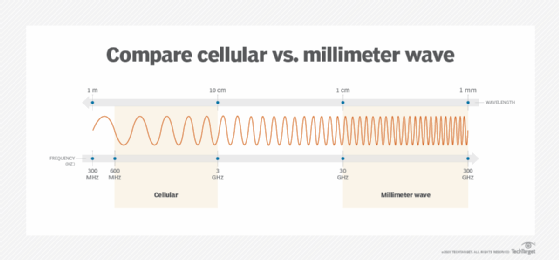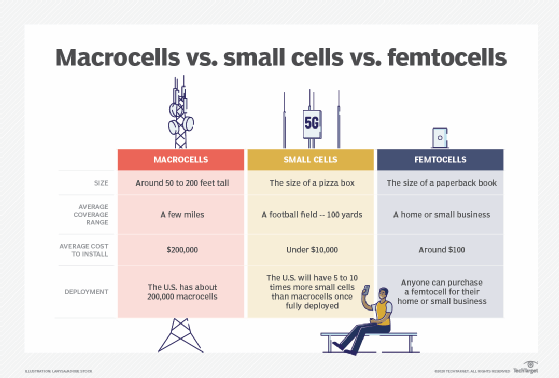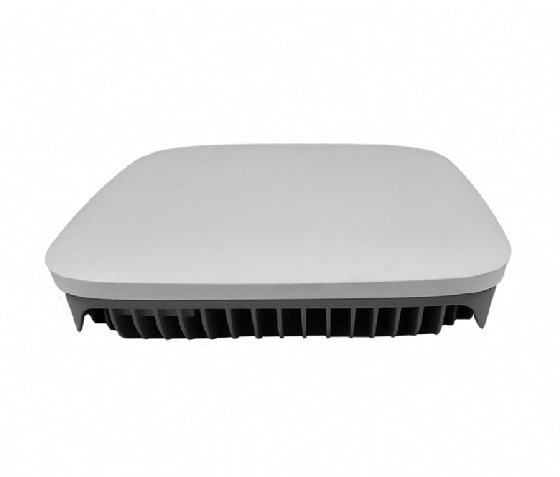5G offers faster download speeds than previous cellular standards, but depending on the frequencies used by base stations, the technology may not be able to provide anything close to the coverage of 3G and 4G networks.
5G operates in three frequency bands, each with its own benefits and challenges.
- Low-band 5G operates between 600 MHz and 900 MHz.
- Mid-band 5G operates between 1 GHz and 6 GHz.
- High-band 5G operates between 24 GHz and 40 GHz.
Low-band 5G is slower than mid-band and high-band 5G, but its longer wavelength allows it to reach further and pass through obstacles like walls and glass. Mid-band 5G, or sub-6 5G, offers more capacity than low-band 5G and wider geographic coverage than high-band. High-band 5G is ideal for high-speed communications, but its short wavelength means it cannot cover long distances.
High-band 5G also uses the millimeter wave (mmWave) frequency band from 30 GHz to 300 GHz. Although the mmWave spectrum offers promising speeds, it suffers from problems such as signal interference, attenuation, reduced capacity, and object intrusion. These drawbacks prevent wireless highband technology from working properly indoors.

In fact, ever since AT&T and Verizon first introduced mmWave 5G, users have found it difficult to access high-band 5G signals. A user can get fast mobile 5G download speeds of over 1 Gbps when outdoors and he is near a 5G base station, but for those who are in the office or working from home, it is always That doesn’t mean it’s possible.
As a result, most carriers have purchased the rights to use frequency bands in all three spectrum bands to expand 5G coverage.
Expand indoor coverage with small cells
Mobile small cells are another solution to this coverage problem. First introduced in 2009 as part of the Third Generation Partnership Project 4G LTE specification, these wireless access points (APs) can increase the density of cellular networks.
Small cells are low-power cellular base stations that operate using a variety of frequencies. Depending on their size, small cells can provide transmission ranges from 40 feet to several kilometers. These mini base stations link back to major cellular networks via Ethernet, fiber, or wireless connections.
Small cells can be deployed indoors or outdoors. Indoor varieties are usually small, about the size of a pizza box. These megabit or gigabit speed gadgets can be installed on the ceiling or walls of your home or office to boost the radio frequency (RF) signal strength of your mobile phone network.
5G networks are increasingly dependent on indoor small cells. This trend is likely to continue as more 5G small cells are introduced into offices, homes, and apartments.

Career development in indoor 5G network space
Access to 5G technology indoors is becoming more commonplace with the rollout of low-band and mid-band 5G cellular networks by mobile network operators (MNOs) in the United States.
The three major U.S. MNOs, AT&T, T-Mobile, and Verizon, currently offer a combination of low-band, mid-band, and high-band 5G networks, and 5G coverage is gradually expanding across the United States. Adding new micro 5G sites will take 12 to 18 months. Being able to deploy infrastructure quickly is an advantage for carriers. Operators are gradually building standalone 5G networks that run on a true 5G core rather than the existing 4G LTE core infrastructure.
General 5G access (indoor and outdoor) has improved over the years as carriers deploy macro network infrastructure such as macro cell base stations. Small cell deployment has been slower than expected as carriers focus on macro networks, but major carriers are looking to expand and strengthen coverage as cellular 5G networks expand. Introducing small cells.

verizon
Verizon, the largest MNO in the United States, has leased 15,000 small cells from shared communications infrastructure provider Crown Castle to support nationwide 5G deployment by 2025. Each 5G radio has a lease term of 10 years. The deal complements his thousands of 5G small cell sites that Verizon has built in-house. Verizon is also deploying small cells that are compatible with the C-band spectrum, operating from 3.7 GHz to 3.98 GHz.
The carrier has purchased frequency band licenses in the low, mid and high band spectrum, with a focus on mmWave frequencies and C-band spectrum at 28 GHz and 39 GHz. Verizon’s 5G Ultra Wideband service primarily relies on C-band and covers his 200 million customers in the US
T-mobile
T-Mobile, the second largest mobile carrier in the United States, also signed a deal with Crown Castle to deploy 35,000 small cells by 2027. The lease term for the unit is 12 years.
T-Mobile primarily relies on low-band spectrum at 600 MHz for its 5G coverage, called Extended Range 5G. Another key element of his 5G strategy for T-Mobile is the 2.5 GHz mid-band spectrum it acquired through its 2020 merger with Sprint. T-Mobile’s Ultra Capacity 5G combines mid-band and millimeter wave frequencies to cover its 260 million customers in the United States.
AT&T
AT&T, the No. 3 MNO, is trying to reduce the time it takes to obtain sites and permits for small cell deployment. AT&T is field testing and deploying commercially available Ericsson Street Radio 4402 small cells in multiple U.S. cities. However, carriers have not disclosed how many indoor or outdoor small cells they plan to deploy.
AT&T offers low-band 5G coverage to 290 million customers in the U.S., but its 5G+ service uses a combination of mid-band and mmWave spectrum.
How do small cells help with 5G indoor coverage?
Despite plans from major MNOs, most 5G small cells will be deployed by private companies. IDTechEX predicted that by 2031, 45 million of his 5G small cells will be distributed around the world.
Some of these small cells will be installed by companies looking to build their own private 5G networks for business use cases. For example, according to the Small Cell Forum, manufacturing, utilities, energy, retail, and transportation companies are the largest investors in small cells because of their need to support large geographic areas. By combining a private 5G core with a small cell network, enterprises can implement a secure, reliable, low-latency, and high-speed private network on-premises.
Despite all the hype around private 5G, it won’t become more mainstream until 2025 or 2026. In the meantime, companies continue to install indoor small cells, albeit using microradios connected to the MNO’s public network.
The increased density of 5G networks will significantly improve indoor coverage. As previously mentioned, indoor environments are not particularly suitable for high-band mmWave 5G radios. Walls can completely block high-band signals, but even mid-band 5G RF can be weakened by office partitions and furniture.
Businesses that need to give their employees access to high-speed data downloads of 1 Gbps or higher over cellular networks can deploy multiple mmWave small cells to ensure reliable, uninterrupted data coverage indoors. I need it.
The majority of 5G small cells being deployed will likely use mid-band or low-band frequencies. These bandwidths are not completely dependent on compatible indoor microradios to provide coverage, but businesses that rely on a stable 5G signal indoors will definitely need mid-band 5G. You should consider installing small cells.
distributed antenna system
Many businesses use distributed antenna systems (DAS) to transmit cellular signals throughout a building from a central source. Small cell networks can complement these systems to improve indoor mobile coverage.
DAS vendors such as CommScope and Corning are working with major carriers to install indoor antenna systems in hotels, hospitals, large office buildings, and stadiums. However, according to cell signal enhancement provider Waveform, deploying DAS is more expensive than installing one or more small cells within a building, and costs vary depending on supported frequencies and equipment.
Wi-Fi6
Many small businesses can use Wi-Fi to provide indoor mobile coverage to their employees, especially since most cell phones available these days support Wi-Fi calling. The latest Wi-Fi 6 — 802.11ax — APs increase throughput and reduce congestion on public network bandwidth. Compared to previous Wi-Fi standards, Wi-Fi 6 has improved interoperability with his 5G services, allowing for more heterogeneous networks when using both technologies.
Key players in the indoor 5G space
Prominent vendors in the 5G small cell market include, in alphabetical order:
- air span.
- Cisco.
- CommScope.
- Ericsson.
- NEC
- Nokia.
- Samsung.
The blocklisting of Chinese vendors Huawei and ZTE Corporation in 2019 fractured the global radio access network market, including small cells. The United States and parts of Europe ban Chinese vendors from selling telecommunications infrastructure. In the rest of the world, Huawei is the top communications vendor.
Editor’s note: This article was originally written by Dan Jones and has been updated to reflect changes in the industry.


